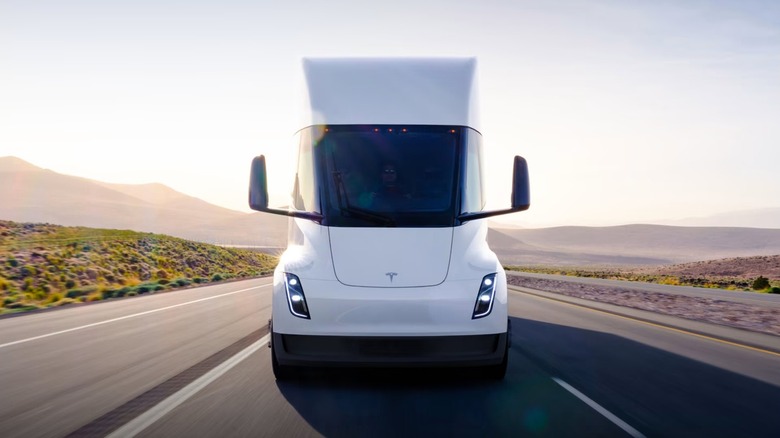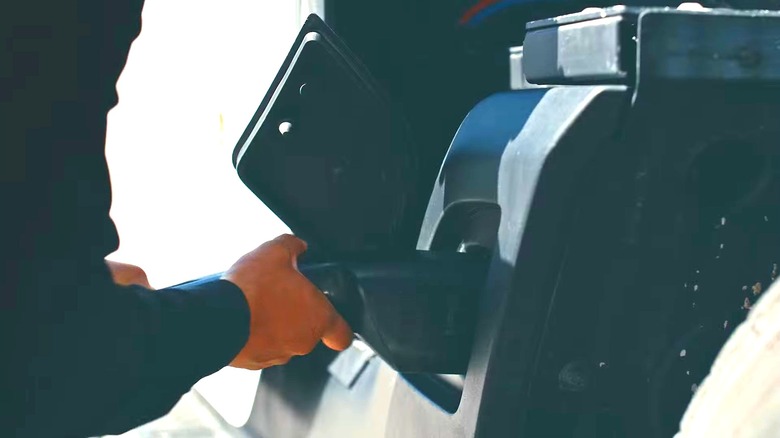How Truckers Really Feel About The Tesla Semi Truck
The first U.S. trucking manufacturer to make diesel engines standard across its line was Kenworth, all the way back in 1933. Fast-forward nearly a century, and the much-anticipated electric big rig has finally made it into the hands of veteran truckers, and there's a reason why the Tesla semi was delayed so long. Given its significant departure from traditional diesel power, you may be surprised to learn that the drivers who have operated the Tesla semi have had generally positive experiences to report. However, others in the industry have expressed some concerns.
On the positive side, the North American Council for Freight Efficiency (NACFE) on its Run on Less by NACFE YouTube channel, showcased some interviews in its video, "Saia: Run on Less – Messy Middle Fleet Profile" with SAIA truckers who had the opportunity to operate the Tesla semi. The benefits praised by the drivers included an enhanced turning radius, making navigating urban environments less cumbersome, and the ample amount of performance power without any perceivable downgrades from diesel. One driver praised how phenomenal the navigation system and various exterior cameras were at supporting operation.
However, there were some issues expressed from those who have been behind the wheel of this Tesla, and from experienced truckers that haven't driven one yet, but already foresee some problems. The concerns surrounded external impacts like wind on the truck's range, how charging times would impact driver pay, and the Tesla's unique center seat design.
Range, and charging concerns
While there was plenty of positive feedback, one trucker did acknowledge one of the challenges with an electric semi truck. Tesla claims its semi can go up to 500 miles on a single charge, but it's important to remember the number of variables that can influence this figure, putting into question how much range a Tesla semi really has. As one veteran driver explained, something as simple as wind can dramatically drop the capable range, which could potentially alter travel plans such as requiring an earlier stop at a charging station than originally planned.
Another trucker with around two decades of driving under his belt offered up his concerns (although he hadn't had any time yet in the Tesla). While Tesla states that its semi can rack up a 70%charge of its total range in just a half an hour (with fast charging), which is impressive, it still poses a challenge for operators in terms of pay. Typically, over-the-road drivers aren't paid per hour, which means that essentially, if the truck isn't moving, a trucker isn't getting paid. And 30 minutes is the best-case scenario, but in reality, might be much more depending on the circumstances.
The center driver's seat
Very futuristic-looking, the inside of Elon Musk's semi places the driver directly in the center instead of the left side, which is considered one of the coolest features of the Tesla semi's high-tech interior. However, one trucker voiced their worry with this unique setup when trying to reverse the truck. With the driver's seat on the left side, a trucker can peer out the window for better visibility, while relying on mirrors on the right side. With the seat in the middle, backing operations are completely relying on mirrors and cameras.
According to YouTube channel Torque News on its video, "Pepsi Tesla Semi: Trucker's Review of Center Seat's Main Issue," one of the drivers for Pepsi operating a Tesla semi, pointed out a challenge they faced when stopping at the various check-in gates for cargo drop-off. These gate houses are designed to allow a trucker to exchange paperwork with facility staff without leaving the vehicle, by handing it out the left side window. However, the convenience of this operation is lost with the seat being located in the center. This requires the driver to get up from their seat in a more awkward motion during deliveries.


